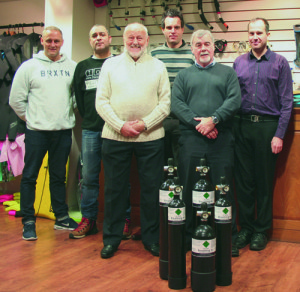More than just a collection of hoses and bottles, the PCP charging market is really taking off. Midland Diving’s Mark Humphreys explains the benefits of high-end charging kit
Once upon a time, a hose was a hose, and PCP airgunners would assemble charging apparatus out of whatever kit they could lay their hands on. But with the emergence of a number of companies supplying high-end charging gear in various forms, combined with a greater degree of education for airgunners in general, we’ve left those times behind.
Midland Diving is one of those companies. Based in Leicester, it’s a family-owned company that’s been supplying purpose-built airgun charging gear to the trade for over 30 years. Sales director Mark Humphreys says a lot has changed even in the last decade: “There used to be a lot of misconceptions over what people could and couldn’t do. We used to get people ringing the office, asking if they could use their gas cylinders, barbecue cylinders – or referring to them as oxygen cylinders, when you’d never put oxygen in a gun.
“Those misconceptions have become fewer and fewer. But what does still exist is people trying to do it on the cheap. They spend thousands of pounds on a gun and then want to fill it with a very cheap cylinder, thinking it doesn’t matter. We try to dispel the thinking behind that, and show them that a better cylinder is cost-effective.”
The name gives away that Midland Diving isn’t native to the gun trade – it’s an import from the diving industry, which already champions high standards for compressed air and imposes a mandatory two-and-a-half year testing standard for all cylinders. But Mark is at pains to emphasise that simply taking a diving bottle valve and using it on an airgun won’t cut it. “What we manufacture is not a rebranded product; we haven’t taken an existing valve and modified it. We’ve gone to our designers, done in-house designs and come up with a product that is specifically for the airgun market. You could never use it in the diving industry – it doesn’t even look like anything you go diving with.”
So what’s the difference? For one thing, the pressures and connectors required tend to be different for airguns. And the regulatory requirement is relaxed too, as Mark explains: “In the diving industry, the two-and-a-half-yearly tests alternate. Firstly you’ll have a visual test, and next time it’ll be a hydrostatic test. In the airgun industry you just skip the visual test and have a hydrostatic test every five years. So it’s not quite accurate to say airgun cylinder testing is only half as strict.
“And for all compressed air cylinders – diving, airgun or anything else – there are transportation requirements. Specifically, you need to display a warning diamond on your vehicle whenever you’re carrying a cylinder. That diamond will dictate how the emergency services treat you if you get into a crash – so it’s equally important you take it off when you’re not transporting compressed air.
“What we’ve ultimately done is produce a magnetic version of that warning diamond, so it’s easy to put on and take off when you need.”
Additionally, testing for airgun chambers could be on the horizon – though this could well be a voluntary code as opposed to a legislative one, since in many cases British manufacturers are taking it on themselves to ensure testing is carried out. It’s not just manufacturers either – end-users have become more demanding about their kit. “Over the years we’ve definitely seen a shift. People are a bit more tech-savvy and they want a bit more from what once was just a basic item to fill their airgun with. We try to give them what they want.”
When you’re talking about highly compressed air, that means going to the ends of the earth to source parts that guarantee reliability. “We work with the largest valve manufacturer in the industry – an Italian-based supplier,” says Mark. “They make millions of valves a year, for the likes of Calor Gas. The materials they use are top-quality – it’s not second-hand brass or remanufactured brass, it’s directly from the mill.
“Plus we are one of the only manufacturers that heat-treats the valve. The valve is forged, chrome plated and machined, and once this is completed the valve is heat treated for 12 hours at a maximum of 280C to alleviate work hardening and prevent stress cracking later in life.” That’s all very well, but will it help dealers sell the product? Mark admits it’s not the most marketing-friendly of innovations – in fact it’s something the consumer is likely never to even notice. But Midland Diving is committed to the standard, purely in the name of quality: “To be honest, the end user won’t be that bothered about a lot of the technical innovations we incorporate. But it’s something that we pride ourselves on, and always have done. A product that’s working well is one you don’t notice.” The benefit for dealers comes, of course, when you get few returns and a high rate of repeat business.
What’s more noticeable about Midland’s cylinders is their black colouring – not just an aesthetic gimmick but another practical addition. “We’ve changed the finish we use on cylinders – it’s not just a standard wet-paint finish any more. It’s a finish that’s used in the automotive industry – it’s hard-wearing but also flexible. It stands up to being hauled out of a car and across fields, and doesn’t scratch, chip or damage as easily.”
So is there a constant R&D process going on at Midland Diving, looking to improve the products all the time? There is – but Mark says that once again, you’re unlikely to notice its fruits. Most of the time it’s not about reinventing the wheel but about refining the existing design based on dealer feedback. “We’ve made changes over the years. We introduced a smaller, thinner gauge, which is less prone to damage. Plus, we have worked closely with our existing manufacturer to produce a new valve, and introduced flow restrictors into the valve.
“Right now the only development we’re working on is a change to our internal restrictor. We did get feedback from a few dealers that it was flowing a bit too fast, so we’ve finalised a new design to slow that flow of air down. Just to tweak it a bit for the dealers. They’ve fed that back to us, so we’ve reacted.”
The Midland Diving product range is based around 3-, 4-, 7- and 12-litre cylinders, each coming with the valve with integral gauge, associated fittings and accessories. “Other than filling it with air, it’s a ready-to-go package,” says Mark. And servicing it is easy too: “We offer a service kit, but rather than just being a bag of o-rings, seals and screws, it all comes pre-assembled. To service a valve, you just take the handle off, take the internals out, chuck them in the bin, and screw one screw back in again. Then you’ve got all-new internals and valve. It makes it as easy as possible, and there’s no messing around for the service agent.” The bottom line is that it is easier than ever for end-users to take advantage of proper charging equipment – and that means retailers can take advantage of the demand too.
Contact Midland Diving: 0116 212 4262, www.midlanddiving.com.









Comments are closed